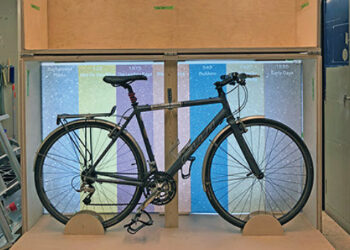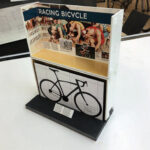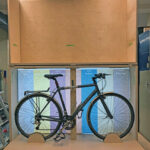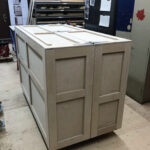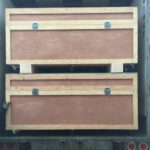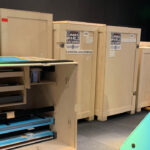Crates are widely used components of travelling exhibitions and yet they seem to often be overlooked. How can the overall experience be improved for everyone involved in crating for touring exhibitions? How can we make crates more cost efficient and more environmentally responsible? Two online workshops, “Crate Expectations” and “Hacking the Crate”, hosted this summer by Science North in collaboration with Kubik Maltbie and Origin Studios, questioned crating for the touring exhibits industry. Kathryn Huneault, Manager, International Sales Operations, and Troy Rainville, Senior Manager, International Sales at Science North, share the key findings of the research.
Teo: Crating is often one of the last things people think about when developing a touring production. And yet all touring exhibitions rely on that mechanism to come to life and circulate. This summer, your team explored in workshops, combined with an industry wide survey, possibilities to improve the planning, production, and use of crates in touring. What led you to focus on crates?
Kathryn: The initial spark came from our technical team. They are very familiar with crates, as they physically handle them on the exhibits we tour and manage incoming travelling exhibits which visit our sites. They have been pointing out original systems as well as difficulties they have come across when welcoming exhibits and using our crates.
Troy: At Science North, we develop and tour exhibitions, and we continuously look into innovation in travelling exhibits. We had opportunities to see other exhibits and their crating with new innovative ways sparked our curiosity. We felt that there were maybe some opportunities to explore crating as one potential area of innovation in touring.
What makes crates important for the touring process?
Kathryn: When developing an exhibit, it is easy to get really excited about the art, pieces of collection or specimens you are going to include, and about the science that you are going to communicate to the audience. Often there is less thought put into crating. We are very focused on the experience, but crates are the systems that keep it all safe and transportable for the mobility process. And they have major shipping, storage and costs implications that impact a touring project. Fewer and fewer locations can actually store crates on site and coming out of the year that we just had, that additional cost is a huge barrier for those who have seen revenue drop significantly in the past year.
Troy: Crates have so many implications, for exhibition design, health and safety, the environment, the management of remote installations. And they are used for 5 to 8 years. With the workshops, we wanted to trigger conversations about how to improve their usability and their ability to protect content, about how to make the sharing of exhibits a better experience for everyone, and about how crating could become more environmentally responsible.
For the research, you developed a comprehensive approach, trying to consider the viewpoints and requirements of all stakeholders involved in the design, production and use of crates. Who are the key stakeholders on the crate’s journey?
Troy: We knew the research could not be done in a bubble, we needed to bring in different viewpoints from around the world, from the whole ecosystem along the crating journey. Many stakeholders in the touring process are downstream from the crating creation, they are just living with what has been produced. So, we invited people from producing and receiving institutions, travelling exhibits teams, designers, fabricators, conservators, installations teams, fine art, and exhibit shippers, as well as independent project managers and insurance providers, to engage with all the touch points.
What are the key aspects that need to be considered in the development of a crating strategy for a travelling exhibition?
Kathryn: What came out of the workshop is that in our industry, crating may not be considered from concept development, and specialists are rarely consulted. Assessing crating feasibility as part of initial project development and requesting advice from crating and shipping experts, can make a big difference. Crating should be considered from a strategic standpoint, to always make sure that we are not crating for the sake of crating, that alternative options are being considered, and that the use of space is being maximised.
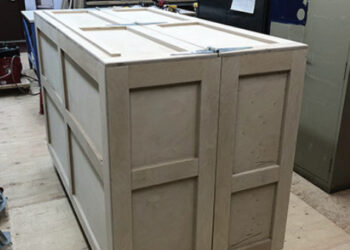
Crating needs to be more than just a line item in a budget and it needs to be considered in the light of sustainable development.
Troy: In our survey, 50% of respondents said weight and dimensions are the most important factors when it comes to temporary exhibition crates. And 85% of people said that they are often concerned about contents and staff safety while exhibition crates are being handled. So, considering crating as part of the build and not an afterthought is key. Crating needs to be more than just a line item in a budget and it needs to be considered in the light of sustainable development. We need to illustrate the value along the path. Understanding that maybe putting a little bit more money at the beginning into crating and the design element, and thinking about crating, its impact and reusability as we are developing the exhibit, could save money, help with the environment, make it a better experience for our clients, be better on the insurance side and for health and safety, and be less costly to ship as it weighs less and can fit in less trucks or containers.
Did the research lead to identify an ideal crating system?
Troy: The topic of crates is complex. Throughout the workshops, we realised that there is not really a perfect crate. Standardisation still ranks high, but in the current circumstances, it is just not possible, nor fully desirable.
Kathryn: The plywood case is here to stay, but there are innovations happening in the field that can suit different applications. Interesting alternatives that were discussed included 3D printed moulded foam fitted to the size of the protected piece, with an enormous reduction in weight; modular systems using aluminium and no MDF; lighter and easier to access reusable metal travelling racks, collapsible racks; custom fit packing and protecting blankets. In some cases, crates can even be integrated into the exhibition design, remaining on display as part of the exhibit.
What’s next for innovation in crating?
Troy: When carrying out this research, it was important for us that it could benefit more widely in the industry. We are happy to share the full report, which presents the survey results and workshops conclusions. We look forward to continuing the conversation with other members of the industry, sharing new ideas on innovation, improvement, and sustainability in crating for future travelling exhibitions.
The Secret Life of Crates
Please find here the full 2021 Secret Life of Crates report on touring exhibitions.

About Kathryn Huneault
Kathryn has been a part of the Science North team since 2012, with most of her career spent in the management of front-of-house operations for the Food and Functions businesses. In 2019, Kathryn stepped into the role of Manager, International Sales Operations and is currently responsible for organising and monitoring the movement of Science North’s travelling exhibitions and those tour-managed for external clients. Her passion for building mutually beneficial relationships, and providing stellar customer service, contribute to the success and sustainability of the business, all while driving team growth, capacity and operational improvement.

About Troy Rainville
Troy is the Senior Manager of International Sales at Science North, where he leads operations and business development for the portfolio of services and exhibits. Troy has developed his expertise over the past 20 years working in the hotel and tech industries, where he notably served as Chief Operating Officer for an international technology-based company. Troy has been involved in many national and international projects at Science North, including the newly redesigned and rebranded Nature ExchangeTM experience and the international touring of their Ripley, Guiness, Arctic and Gaming exhibitions.


